Autumn Flowers in Japan: 24 Varieties with Viewing Spots

Discover 24 Japanese autumn flowers that are best viewed from September to November, such as cosmos, spider lilies, and chrysanthemums, along with viewing spots.
Japan's Autumn Flowers: From September to November
Autumn in Japan is a season filled with vibrant flowers, allowing us to fully enjoy the beauty of nature. Autumn flowers can be appreciated not only for their beauty but also for their fragrances and atmosphere.
In this article, we will provide a detailed introduction to autumn flowers in Japan, their peak blooming times, and recommended spots for viewing.
Autumn Flowers in Japan
1. Cosmos Flowers
2. Yellow Cosmos
3. Osmanthus: Fragrant Olive (Kinmokusei)
4. Chrysanthemums
5. Roses
6. Shuumeigiku (Japanese Anemone)
7. Dahlia
8. Bellflower
9. Red Spider Lily (Higanbana)
10. Gentian
11. Japanese Toad Lily (Hototogisu)
12. Cockscomb
13. Salvia (Salvia splendens)
14. Sasanqua Camellias
15. Susuki: Silver Grass
16. Maple Leaves (Momiji)
17. Goldenrod
18. Salvia Japonica
19. Ominaeshi (Lady's Eardrop)
20. Leonurus Macranthus (Kisewata)
21. Agrimonia Japonica (Kinmizuhiki)
22. Fall Begonia (Shuukaidou)
23. Aconite (Torikabuto)
24. Asian Jumpseed (Mizuhikiso)
1. Cosmos Flowers

Cosmos is a representative perennial flower of autumn in Japan. The name is said to be derived from the Greek word "Kosmos," meaning "harmony" or "beauty."
The shape of the petals resembles that of cherry blossoms, which is why in Japanese it is written as 秋桜 (Aki-sakura), meaning "autumn cherry blossom."
From September to November, cosmos flowers bloom all over Japan, and vast cosmos fields are particularly popular tourist attractions. The sight of colorful flowers blooming all at once is breathtaking and is a favorite spot for photography enthusiasts and families.
While pink is the most famous color of cosmos, they also come in white, orange, yellow, and even black.
The pink variety symbolizes "maiden's purity," while the white symbolizes "grace" and "beauty," so be sure to check the meanings of the flower when giving them as gifts!
Perennial: A type of plant that does not wither with the changing seasons and blooms each year.
Viewing Spots for Cosmos
Eastern Japan: Showa Kinen Park (Tokyo), Hitachi Seaside Park (Ibaraki)
Western Japan: Flower Expo Memorial Park Tsurumi Ryokuchi (Osaka), Expo Commemorative Park (Osaka), Osaka Municipal Nagai Botanical Garden (Osaka)
2. Yellow Cosmos

Yellow Cosmos produces vibrant yellow and deep orange flowers. Its flower language represents "wild beauty" and "harmony." With its strong and energetic appearance, it resembles a small sun.
A key characteristic of yellow cosmos is its earlier blooming period compared to regular cosmos flowers, allowing for enjoyment from around June to late October.
Originally from Mexico, it was introduced to Japan during the Taisho era (1912–1926) and became widely loved.
Due to its resilience to heat and robustness, it is favored by beginner gardeners. Yellow cosmos is easy to grow and readily available, so you will often see it not only in park flower fields but also in residential gardens.
Viewing Spots for Yellow Cosmos
Eastern Japan: Showa Kinen Park (Tokyo)
Western Japan: Expo Commemorative Park (Osaka), Fujiwara Palace Site Flower Garden (Nara)
3. Osmanthus: Fragrant Olive (Kinmokusei)

Osmanthus or the Fragrant Olive is a tree that blooms with numerous small orange flowers from late September to mid-October, releasing a sweet and rich fragrance. It is often cultivated as a garden tree or street tree, and in autumn, its scent wafts far and wide.
Osmanthus is originally from China, where it is known as Guihua. In China, there is a type of liquor called Guihua Chenjiu made by infusing fragrant olive flowers. It was introduced to Japan during the Edo period (around 1600 to 1868).
In addition to the orange-flowered osmanthus (Kinmokusei), there is a white-flowered variety called Ginmokusei, which, however, does not have as strong a fragrance.
Both are enjoyed as familiar autumn flowers in various locations, so be sure to look for them!
Viewing Spots for Fragrant Olive
Eastern Japan: Shinjuku Gyoen National Garden (Tokyo), Yoyogi Park (Tokyo)
Western Japan: Osaka Castle Park (Osaka), Toji Temple (Kyoto), Nishi Honganji Temple (Kyoto)
4. Chrysanthemums
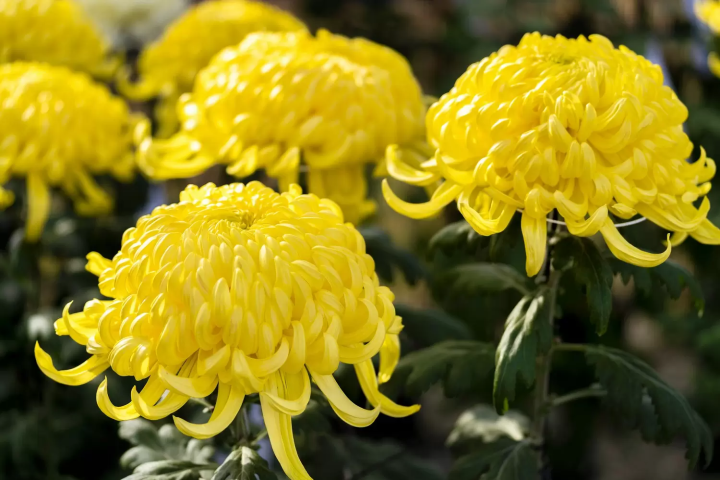
Chrysanthemums, known as "kiku" in Japanese, hold a significant place in Japanese culture. They are celebrated for their beauty and are regarded as a symbol of longevity and rejuvenation.
Chrysanthemums bloom in autumn, making them a popular flower during this season. In early November, chrysanthemum festivals (Kiku Matsuri) are held in various locations, where people admire carefully cultivated blooms and participate in traditional events.
In Japan, the chrysanthemum is associated with the imperial family and symbolizes the sun. The Imperial Seal of Japan features a 16-petal chrysanthemum, highlighting its importance as a national emblem.
Moreover, chrysanthemums are often used in traditional ceremonies and are a common motif in art and literature.
Viewing Spots for Chrysanthemums
Eastern Japan: Jindai Botanical Garden (Tokyo), Kameido Shrine's Chrysanthemum Festival (Tokyo), Tokyo Chrysanthemum Festival in Hibiya Park (Tokyo)
Western Japan: Shukkeien Garden's Chrysanthemum Festival (Hiroshima)
5. Roses

The glamorous rose is often associated with blooming in spring to early summer, but it also displays beautiful blooms in autumn.
The flowers are somewhat smaller, and the cool autumn climate enhances the fragrance of the roses, bringing a rich scent to gardens and parks. When enjoying autumn roses, it’s a good idea to choose based not only on color and appearance but also on their fragrance.
Autumn roses tend to have deeper and richer colors, having survived the summer heat. There are also red roses with a dark hue known as black roses, which get even deeper in color during the autumn.
Various autumn rose festivals and flower events are held in many locations, so it's worth checking them out.
Best Viewing Times and Spots for Roses
Eastern Japan: Jindai Botanical Garden (Tokyo)
Western Japan: Nakanoshima Rose Garden (Osaka)
Read also
6. Shuumeigiku (Japanese Anemone)

Shuumeigiku (Japanese Anemone) is an elegant flower that blooms from mid-August to November.
It is said to have been brought from China in ancient times, and in the Kifune region of Kyoto, wild Shuumeigiku can be observed. This variety is affectionately known as "Kifune-giku."
Wild Shuumeigiku can be found throughout Japan, and they are sometimes referred to by local names such as Echizen-giku or Kaga-giku.
Despite having "giku"in its name, Shuumeigiku is not a type of chrysanthemum but belongs to the anemone family. In English, it is called Japanese Anemone, characterized by its small and delicate white or pink flowers.
Its slender and graceful stems sway gently in the wind, evoking the beauty of autumn.
Viewing Spots for Shuumeigiku
Eastern Japan: Shinjuku Gyoen National Garden (Tokyo)
Western Japan: Zenmineji Temple (Kyoto)
7. Dahlia

The vibrant dahlias reach their peak bloom from September to November.
The name "dahlia" is derived from the 18th-century Swedish botanist Anders Dahl. It is said to have been introduced to Japan in 1842 and has since been cultivated extensively.
Dahlias come in many varieties, allowing people to enjoy flowers in a wide range of colors, including red, pink, yellow, and white. They are also popular as cut flowers, bringing the autumn atmosphere indoors.
Various events showcasing the beautiful dahlias are held across the country in autumn.
This fall, consider incorporating dahlias into your garden life for a burst of color and beauty!
Viewing Spots for Dahlias
Eastern Japan: Ofuna Botanical Garden (Kanagawa)
Western Japan: Hyogo Prefectural Flower Center (Hyogo)
8. Bellflower

Bellflowers (Kikkyo) are beautiful perennial flowers symbolizing autumn in Japan, characterized by their pentagonal shape. Their well-formed petals exude elegance, imparting a sense of quiet beauty to those who view them.
The best viewing time is typically from August to October, and it can be enjoyed in various locations across Japan.
Bellflowers have been deeply intertwined with Japanese culture for centuries, appearing in waka poetry, haiku, and the tea ceremony. It is celebrated as a seasonal symbol in many poems. The root of the bellflower is also used in traditional medicine, known for its potential to soothe throat inflammation and alleviate pain.
While the clear blue-purple flower is the most commonly recognized variety, there are also white and pink varieties. The flower language represents "eternal love" and "sincerity," making it beloved by many for its meaning as well.
Viewing Spots for Bellflower
Eastern Japan: Mukojima Hyakkaen Garden (Tokyo), Hakone Wetland Flower Garden (Kanagawa)
Western Japan: Ryozenji Temple (Kyoto)
9. Red Spider Lily (Higanbana)
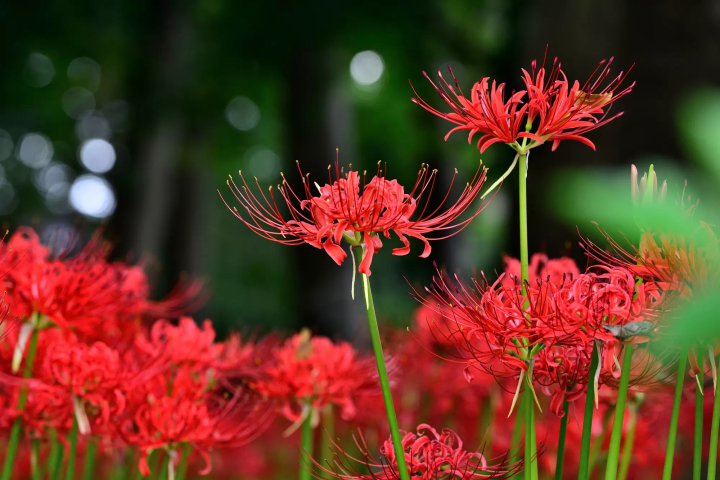
The Red Spider Lily is a perennial flower widely recognized as a symbol of autumn, characterized by its vibrant red flowers.
The Japanese name "Higanbana" comes from the fact that it blooms during the Buddhist observance of Higan (Autumn Equinox), around mid-September.
You can often see this flower in graveyards and along the edges of rice fields, where it typically grows in clusters. Deeply rooted in the Japanese landscape, its striking red color signals the arrival of autumn to many.
While the slender stems and delicate petals of Higanbana are beautiful, it's important to note that its bulbs are toxic, so care should be taken when handling them. With a unique beauty, Higanbana stands out from similar flowers, making its presence truly one-of-a-kind.
Viewing Spots for Red Spider Lilies
Eastern Japan: Kinchakuda (Saitama)
Western Japan: Ohara no Sato (Kyoto)
Read also
10. Gentian

Gentian is popular as one of the representative flowers of autumn. Its blooming period is long, lasting from August to November, and it is known as a flower that signals the arrival of autumn.
The flower's meanings are "justice" and "sincerity," which further enhance its noble impression. While the blue-purple variety is the most famous, there are also pink and white gentians.
Some gentian species are used in traditional Chinese medicine and are said to be effective for joint pain, muscle pain, and pain in the legs and lower back.
Gentian prefers wetland environments and can be seen growing wild. Let’s go out and see the gentians that add color to the autumn landscape.
Best Viewing Times and Viewing Spots for Gentian
Eastern Japan: Shika Kogen (Nagano)
Western Japan: Rokko Alpine Botanical Garden (Hyogo)
11. Japanese Toad Lily (Hototogisu)

The Japanese Toad Lily (Tricyrtis hirta) is a unique and charming autumn flower. It is characterized by its distinctive spotted patterns, which resemble the feathers of the common cuckoo (also called "hototogisu" in Japanese).
There are many varieties, including some that are native to Japan. The flower colors typically include white, purple, and yellow, often with spotted patterns, though there are some varieties that feature completely white petals without any spots.
Its modest yet beautiful flower shape evokes a sense of traditional Japanese aesthetics. The serene allure of Hototogisu makes it popular for decorating Japanese rooms and for use in tea ceremonies.
The blooming period is from September to October. It prefers bright shade and can be found on slightly damp slopes, cliffs, and rocky areas.
Best Viewing Times and Spots for Hototogisu
Eastern Japan: Shinjuku Gyoen National Garden (Tokyo)
Western Japan: Kyoto Gyoen (Kyoto), Kyoto Prefectural Botanical Garden (Kyoto)
12. Cockscomb

Cockscomb is an annual plant believed to originate from the tropical regions of Asia and Africa.
True to its name, it features a unique, rounded shape that resembles a rooster's comb. There are also varieties with fluffy, feather-like shapes, and the flowers come in various colors, including red, orange, yellow, and pink.
The meanings associated with this flower include "poser," "individuality," "quirkiness," and "fashionable." Its unique appearance and vibrant impression are well reflected in its meanings.
Cockscomb is resilient to heat but sensitive to cold, making it a popular choice for mixed plantings and gardening. It can often be seen in flower beds at parks.
Its blooming period lasts from July to around November, allowing for an extended enjoyment of autumn colors.
Viewing Spots for Cockscomb
Eastern Japan: Nasu Flower World (Tochigi), Musashino Hills Forest Park (Saitama)
Western Japan: EXPO Park Flower Square (Osaka), Anjo Denpark (Aichi)
13. Salvia (Salvia splendens)

Salvia has many varieties, with around 900 species in total, but the most popular is Salvia splendens, which produces red flowers.
The blooming period is from June to November, making it a prime time for viewing. The herb known as sage also belongs to the Salvia family.
It originates from South America and is typically a perennial plant, but in Japan's climate, it is often treated as an annual. Salvia splendens prefers sunny locations and is relatively hardy and heat-resistant, making it a valuable addition for a colorful garden.
Viewing Spots for Salvia
Eastern Japan: Shinjuku Gyoen National Garden (Tokyo), Mother Farm (Chiba Prefecture)
Western Japan: Awaji Hanasajiki (Hyogo), Kyoto Prefectural Botanical Garden (Kyoto)
14. Sasanqua Camellias
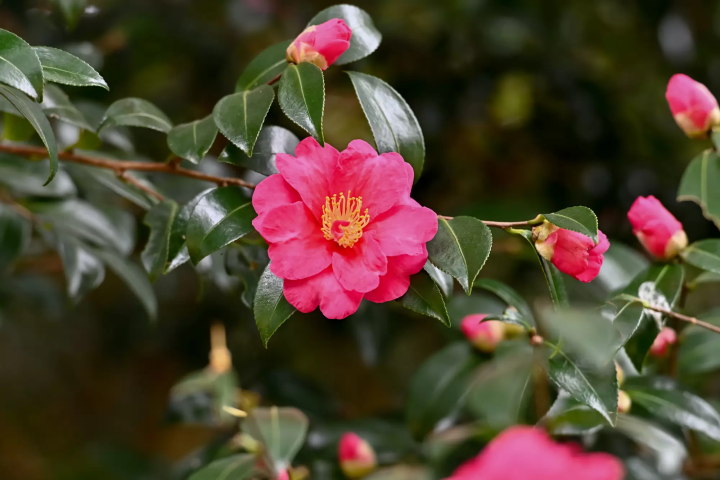
Sasanqua (Camellia sasanqua) is a beautiful evergreen broadleaf tree from the camellia family, widely cherished in parks and gardens.
It blooms from autumn to winter (October to December), making it known as a flower that marks the transition of the seasons.
Sasanqua camellias are characterized by their bright pink and white flowers. While their appearance is similar to that of camellias, sasanqua flowers drop petal by petal, whereas camellia flowers fall off completely from the base. Additionally, camellias bloom from winter to spring, unlike sasanqua.
Sasanqua camellias thrive well in shady conditions, which has made them popular not only for cultivation in gardens and parks but also for use as hedges. This plant has a deep connection to the landscape and garden culture of Japan.
Viewing Spots for Sasanqua
Eastern Japan: Koishikawa Botanical Gardens (Tokyo)
Western Japan: Kobe City Arboretum (Hyogo)
15. Susuki: Silver Grass

Pampas Grass (Susuki), also known as Silver Grass, has been cherished as an autumn symbol throughout Japan. It grows naturally in various regions, often found in mountains and along the edges of rice paddies, showcasing its adaptability to different environments.
There is a nickname "Obana," derived from its resemblance to animal tails. The distinctive spikes of pampas grass feature slender leaves that bundle and spread out gracefully, creating a beautiful sight as they sway in the autumn breeze.
Particularly stunning is their motion during twilight, where the spikes illuminated by the setting sun create a golden shimmer, resulting in a picturesque landscape.
This natural beauty has long been deeply rooted in Japanese culture and has been used for decorations during Japan's Moon Festivals.
Viewing Spots for Susuki
Eastern Japna: Sengokuhara Plateau in Hakone (Kanagawa)
Western Japan: Tonomine Plateau (Hyogo)
16. Maple Leaves (Momiji, Kaede)

Momiji, the maple foliage, is a beautiful representation of autumn in Japan. Famous spots for viewing autumn leaves, such as Arashiyama in Kyoto, Todaiji in Nara, and Mount Takao in Tokyo, attract visitors from all over the world each year.
While momiji and kaede are quite similar, momiji is characterized by its finely lobed leaves that turn vibrant red and orange in autumn. In contrast, kaede has larger leaves that change from yellow to red.
These trees are at their most beautiful from November to December as autumn deepens. For the best experience of the fall colors, clear days are recommended, as sunlight filters through the leaves, allowing you to enjoy their stunning gradients.
Additionally, the beauty of these trees is not limited to autumn; the fresh green foliage in summer is also a refreshing sight to behold.
Viewing Spots for Momiji and Kaede Foliage
Eastern Japan: Mt. Takao (Tokyo), Irohazaka in Nikko (Tochigi)
Western Japan: Arashiyama (Kyoto), Togetsukyo Bridge (Kyoto), Kakuoin Temple (Kyoto)
Read also
17. Goldenrod (Seitaka Awadachiso)

Goldenrod (Seitaka Awadachiso) is a perennial plant native to North America that can be seen thriving naturally in various locations throughout Japan, such as riverbanks and vacant lots during autumn. True to its name, it grows tall and produces bright yellow flowers.
While it has a very high reproductive capability and has become a concern as an invasive species in recent years, its beautiful blooms add color to the autumn landscape. It is commonly found in vacant lots and parks. Preferring sunny locations, it thrives in a variety of soil types, making it a frequent sight in urban areas.
Goldenrod is also edible. Young shoots can be prepared in dishes like tempura or blanched, making for a tasty treat.
When taking a stroll in the autumn, be sure to enjoy the beauty of its flowers!
Viewing Spots for Goldenrod
Eastern Japan: Tanzawa Mountains (Kanagawa)
18. Salvia Japonica (Aki no tamuraso)

Salvia japonica is a beautiful perennial plant that blooms in autumn and can be found growing naturally in Japan's mountainous regions and grasslands.
Belonging to the mint family, it features clusters of small purple flowers. The flowers are elongated in shape, and the leaves have fine hairs. The blooming period ranges from July to November, providing a relatively long time to enjoy its beauty.
Salvia japonica is often planted in gardens and parks for ornamental purposes, with its striking purple flowers adding vibrant color to the autumn landscape.
Combining it with other autumn flowers enhances the overall harmony and seasonal atmosphere of the garden.
Viewing Spots for Salvia Japonica
Eastern Japan: Komine Park (Tokyo), Mount Takao (Tokyo)
Western Japan: Tsurumi Ryokuchi Park (Osaka)
19. Ominaeshi (Lady's Eardrop)
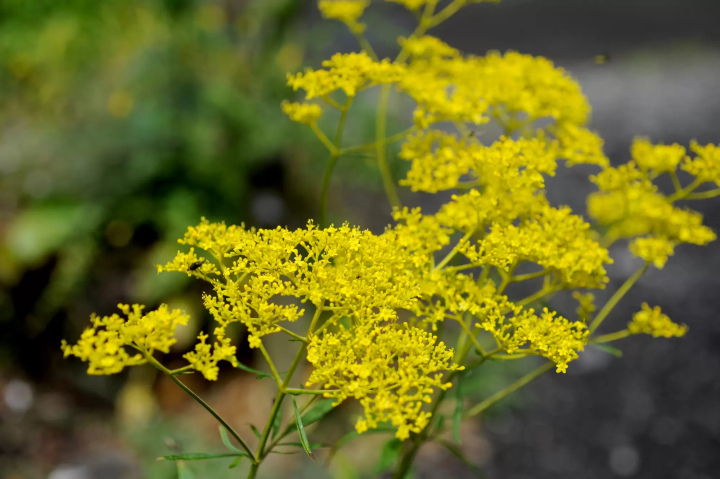
Ominaeshi (Lady's Eardrop) is a perennial plant that blooms in autumn. Its native range extends from Siberia to East Asia, and it can be found throughout Japan.
The name derives from the particularly elegant and beautiful flowers that bloom among autumn foliage. The small yellow flowers densely clustered at the tips of the slender stems resemble twinkling stars.
Ominaeshi is one of Japan's traditional Seven Herbs, and has been cherished for a long time. Its name appears in classical literature, such as the Manyoshu (Japan's first poetry anthology), highlighting its historical significance.
The flower's meanings include "kindness," "beauty," and "ephemeral love," reflecting a delicate and graceful image.
Viewing Spots for Ominaeshi
Eastern Japan: Togokusan - Shinjoji (Saitama)
Western Japan: Asukamura (Nara)
20. Leonurus Macranthus (Kisewata)
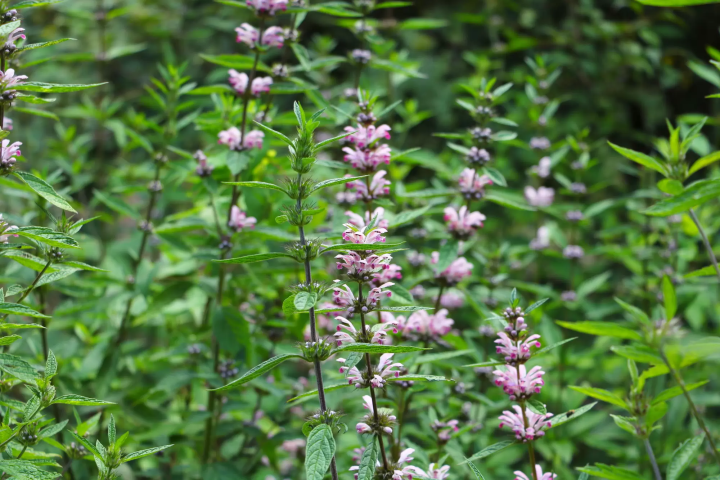
Leonurus macranthus is a perennial plant that blooms in autumn. This member of the mint family typically grows to a height of 60 to 90 centimeters and has been native to Japan for a long time.
The vertically growing stems produce numerous small purple flowers. Its Japanese name originates from the soft, downy texture of its flowers, reminiscent of cotton.
It showcases delicate white and pink flowers, creating a beautiful landscape from October to November.
Traditionally, it was found growing wild throughout the mountains and fields of Japan, from Hokkaido to Kyushu. However, it is now classified as a threatened species, making a chance encounter in the wild quite rare.
Cultivating Kisewata is not particularly difficult, and it is available for purchase at garden centers and nurseries.
Viewing Spots for Leonurus macranthus
Eastern Japan: Nikko Botanical Garden (Tochigi)
Western Japan: Mikamo Botanical Garden (Kochi), Kami Town (Hyogo)
21. Agrimonia Japonica (Kinmizuhiki)

Agrimonia Japonica is a perennial plant belonging to the rose family and is one of the wildflowers that herald the arrival of autumn. It is found growing naturally in various locations across Japan, such as nature parks and mountain trails.
Typically reaching a height of 30 centimeters to 1 meter, it is characterized by its spike-like clusters of small yellow flowers. The blooming period is from July to October, with a particularly high visibility in autumn.
Agrimonia Japonica has been used as an herbal remedy for a long time and is also known by names such as Senkotsuso or Ryugaso. In Japanese folk medicine, it has been used as a digestive aid and an anti-diarrheal remedy. It is said to be effective for fatigue recovery, and in some regions, people even add it to baths.
The flower meanings of Agrimonia Japonica are "gratitude" and "mutual assistance." Since it often blooms in sunny locations like thickets and parks, be sure to look for it as autumn arrives.
Viewing Spots for Kinmizuhiki
Eastern Japan: National Musashino Hills Forest Park (Saitama)
Western Japan: Negoroyama Genki no Mori (Wakayama)
22. Fall Begonia (Shuukaidou)
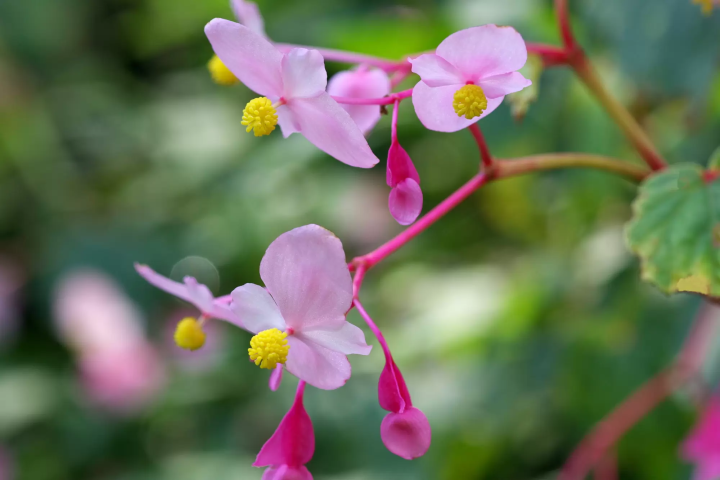
The Fall Begonia is a perennial plant native to China.
It blooms beautiful small flowers in pink and white from August to October. The delicate flowers are known to droop towards the ground, giving rise to floral meanings such as "troubles of love" and "unrequited love."
A similar-looking plant is the quince (Kaido) from the rose family, and it is said that Shuukaidou became known as "the quince that blooms in autumn."
This plant particularly thrives in humid conditions and can grow well in partial shade. Therefore, it is ideal for planting in corners of gardens or under trees. Shuukaidou is easy to care for, making it simple for beginners to cultivate.
Viewing Spots for Fall Begonia
Eastern Japan: Mount Takao (Tokyo), Hase-dera (Kanagawa)
Western Japan: Iwawaki no Mori (Osaka)
23. Aconite (Torikabuto)

Aconite is one of the beautiful perennials that bloom in autumn, with its peak flowering period from August to October.
The petals have a distinctive shape that curls back like a hat. The flowers can be found in colors such as blue-purple, purple, white, and pink, each making a striking visual impact.
While it is popular among enthusiasts for its beauty, it is important to note that it is extremely toxic, requiring careful handling. It has been used as a medicinal plant for a long time, but accidental ingestion can be life-threatening.
There are about 20 species that grow wild, primarily distributed in the Northern Alps. While you might spot them during mountain walks, it’s best to admire them from a distance.
Historically, the toxin from aconite was used in hunting and warfare as poison for arrows. It is said that the Ainu people of Hokkaido used aconite to take down bears.
Viewing Spots for Aconite
Eastern Japan: Tsukuba Botanical Garden, National Museum of Nature and Science (Ibaraki)
Western Japan: Rokko Alpine Botanical Garden (Hyogo)
24. Asian Jumpseed (Mizuhikiso)

Polygonum filiforme
Asian Jumpseed (Polygonum filiform), known as Mizuhikiso in Japanese, is a perennial plant that beautifully decorates autumn gardens.
It is characterized by its slender flower spikes, where the upper half of each flower is red and the lower half is white, resembling the traditional red and white Mizuhiki paper threads used in celebrations, which is the origin of its name.
The Asian Jumpseed is commonly found in deciduous forests and has the ability to thrive in shaded areas, making it suitable for spots in gardens that receive little sunlight.
It blooms from July to October, and its long, swaying flower spikes add an elegant movement to the garden.
Additionally, the flower meanings of Mizuhikiso are "gratitude" and "joy," further connecting it to its auspicious name.
Viewing Spots for Asian Jumpseed (Mizuhikiso)
Eastern Japan: Shinjuku Gyoen National Garden (Tokyo)
Western Japan: Kyoto Prefectural Botanical Garden (Kyoto)
Enjoy Autumn Flowers and Grasses in Japan
The autumn season brings beautiful colors that spread throughout nature, allowing us to enjoy special moments.
Even during your usual walks or on your way to work or school, taking a moment to stop and observe your surroundings may lead to new discoveries.
Enjoy the exploration of autumn nature as you wander through the city!
Read also
All pictures courtesy of Pixta
This is the official account of MATCHA's editorial department. Our articles feature useful travel information for visitors to Japan, from how-to guides to recommended places to visit.

















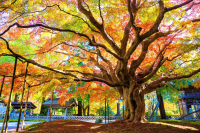
































![[2026] Top 5 Strawberry Picking Spots in Tokushima, Naruto| Farms and Access Guide for January to May](https://resources.matcha-jp.com/resize/720x2000/2025/03/06-227165.webp)



